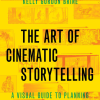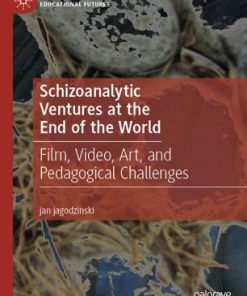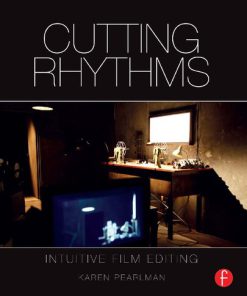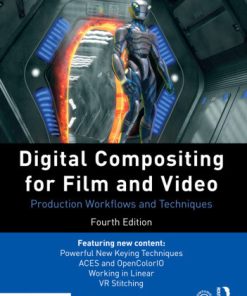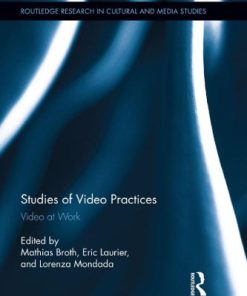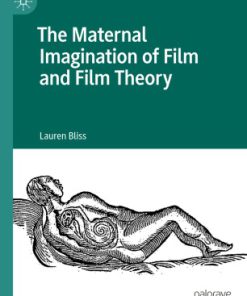The Technique of Film and Video Editing History Theory and Practice 6th Edition by Ken Dancyger ISBN 1351810448 9781351810449
$50.00 Original price was: $50.00.$25.00Current price is: $25.00.
The Technique of Film and Video Editing History, Theory, and Practice 6th Edition by Ken Dancyger – Ebook PDF Instant Download/Delivery: 1351810448, 978-1351810449
Full download The Technique of Film and Video Editing History, Theory, and Practice 6th Edition after payment

Product details:
ISBN 10: 1351810448
ISBN 13: 978- 1351810449
Author: Ken Dancyger
This updated sixth edition of The Technique of Film and Video Editing provides a detailed, precise look at the artistic and aesthetic principles and practices of editing for both picture and sound. Ken Dancyger puts into context the storytelling choices an editor will have to make against a background of theory, history, and practice across a range of genres, including action, comedy, drama, documentary and experimental forms, featuring analysis of dozens of classic and contemporary films.
This new sixth edition includes new chapters on the influence of other media on the editing form, on the importance of surprise in editing, on the contributions of Robert Altman to the art of editing and on the experimental documentary. This edition also includes expanded coverage in technology, creative sound, point of view, and the long take. New case studies explore Whiplash (2014), Room (2015), Lincoln (2012), Tangerine (2015), The Beaches of Agnès (2008), American Sniper (2014), Son of Saul (2015), The Revenant (2015), and many more.
The Technique of Film and Video Editing History, Theory, and Practice 6th Table of contents:
Section 1: History of Film Editing
CHAPTER 1: The Silent Period
- Edwin S. Porter: Film Continuity Begins
- D. W. Griffith: Dramatic Construction
- International Perspectives
- Vsevolod I. Pudovkin: Constructive Editing and Heightened Realism
- Sergei Eisenstein: The Theory of Montage
- Metric Montage
- Rhythmic Montage
- Tonal Montage
- Overtonal Montage
- Intellectual Montage
- Eisenstein: Theoretician and Aesthete
- Dziga Vertov: The Experiment of Realism
- Alexander Dovzhenko: Editing by Visual Association
- Luis Buñuel: Visual Discontinuity
- Conclusion
- Notes/References
CHAPTER 2: The Early Sound Film
- Technological Limitations
- Technological Improvements
- Theoretical Issues Concerning Sound
- Early Experiment in Sound—Alfred Hitchcock’s Blackmail
- Sound, Time, and Place: Fritz Lang’s M
- The Dynamic of Sound: Rouben Mamoulian’s Applause
- Conclusion
- Notes/References
CHAPTER 3: The Influence of the Documentary
- Ideas About Society
- Robert Flaherty and Man of Aran
- Basil Wright and Night Mail
- Pare Lorentz and The Plow That Broke the Plains
- Ideas About Art and Culture
- Leni Riefenstahl and Olympia
- W. S. Van Dyke and The City
- Ideas About War and Society
- Frank Capra and Why We Fight
- Humphrey Jennings and A Diary For Timothy
- Conclusion
- Notes/References
CHAPTER 4: The Influence of the Popular Arts
- Vaudeville
- The Musical
- The Theatre
- Radio
- Notes/References
CHAPTER 5: The Influence of Other Arts
- The Photograph
- The Play
- The Concert
CHAPTER 6: Editors Who Became Directors
- Robert Wise
- The Set-Up
- I Want to Live!
- West Side Story
- David Lean
- Lean’s Technique
- Lean’s Art
CHAPTER 7: Experiments in Editing: Alfred Hitchcock
- A Simple Introduction: Parallel Action
- A Dramatic Punctuation: The Sound Cut
- Dramatic Discovery: Cutting on Motion
- Suspense: The Extreme Long Shot
- Levels of Meaning: The Cutaway
- Intensity: The Close-Up
- The Moment as Eternity: The Extreme Close-Up
- Dramatic Time and Pace
- The Unity of Sound
- The Orthodoxy of the Visual: The Chase
- Dreamstates: Subjectivity and Motion
- Conclusion
- Notes/References
CHAPTER 8: Experiments In Editing II: Robert Altman
- McCabe and Mrs. Miller
- The Company
- Nashville
- Short Cuts
CHAPTER 9: New Technologies
- The Wide Screen
- Character and Environment
- Relationships
- Relationships and the Environment
- The Background
- The Wide Screen After 1960
- Cinéma Vérité
- Cell-Phone Cinema
- Preproduction, Production, Postproduction
- Notes/References
CHAPTER 10: International Advances
- The Dynamics of Relativity
- The Jump Cut and Discontinuity
- Objective Anarchy: Jean-Luc Godard
- Melding Past and Present: Alain Resnais
- Interior Life as External Landscape
- Notes/References
CHAPTER 11: The Influence of Television and Theatre
- Television
- Theatre
- Notes/References
CHAPTER 12: New Challenges to Filmic Narrative Conventions
- Peckinpah: Alienation and Anarchy
- Altman: The Freedom of Chaos
- Kubrick: New Worlds and Old
- Herzog: Other Worlds
- Scorsese: The Dramatic Document
- Wenders: Mixing Popular and Fine Art
- Lee: Pace and Social Action
- Von Trotta: Feminism and Politics
- Feminism and Antinarrative Editing
- Mixing Genres
- Notes/References
CHAPTER 13: The MTV Influence on Editing I
- Origins
- The Short Film
- Where We Are Now—The State of the MTV Style
- The Importance of Feeling States
- The Downgrading of the Plot
- Disjunctive Editing—The Obliteration of Time and Space
- The Self-Reflexive Dream State
- The Media Look at Themselves
- Oliver Stone’s Career
- Natural Born Killers
CHAPTER 14: The MTV Influence on Editing II
- The Case of Saving Private Ryan
- The Case of Ang Lee’s Crouching Tiger, Hidden Dragon
- The Set-Pieces
- The Case of In the Mood for Love
- The MTV Style of In the Mood for Love
- The Case of Life Is Beautiful
- The Set-Pieces in Life Is Beautiful
- The Case of Tampopo
- The Set-Pieces in Tampopo
- Conclusion
- Note/Reference
CHAPTER 15: Changes in Pace
- Evolution of Pace in Filmmaking
- Pace in the Docudrama
- Pace in the Thriller
- Pace in the Action-Adventure
- Pace in the Musical
- Anti-Pace in Tarantino’s Inglourious Basterds
- The Long Take
- Point of View
- Conclusion
CHAPTER 16: The Appropriation of Style I: Imitation and Innovation
- Narrative and Style
- Style for Its Own Sake
- Breaking Expectations
- Imitation Versus Innovation
- Imitation and Innovation
CHAPTER 17: The Appropriation of Style II: Limitation and Innovation
- The Elevation of Cinéma Vérité
- The Return of Mise-En-Scène
- The Close-Up and the Long Shot
- Camera Placement and Pace: The Intervention of Subjective States
- Note/Reference
CHAPTER 18: The Appropriation of Style III: Digital Reality
- Artificial Reality
- Video Over Film
- Constructed Artifice
- The Imagined as the Observational
- Use of Spectacle
- Use of Special Effects
- Realism
Section 2: Goals of Editing
CHAPTER 19: Editing for Narrative Clarity
- The Plot-Driven Film
- Five Fingers
- Mountains of the Moon
- Invictus
- The Character-Driven Film
- Hannah and Her Sisters
- Valmont
- Hero
- The Hours
- Atonement
CHAPTER 20: Editing for Dramatic Emphasis
- United 93
- The Docudrama Effect
- The Close-Up
- Dynamic Montage
- Juxtaposition
- Pace
- Frost/Nixon
- Different Goals, Different Strategies
CHAPTER 21: Editing for Subtext
- The Departed
- Lust, Caution
- There Will Be Blood
CHAPTER 22: Editing for Surprise
- The Case of American Sniper (2014): The Conflicted Goal
- The Case of Daniel (1983): The Dominance of The Past in the Present
- The Case of Rachel Getting Married (2008): Celebration and Tragedy
- The Case of Carol (2015): The Inner Life
CHAPTER 23: Editing for Aesthetics
- Brighton Rock
- The Third Man
- The Passion of the Christ
Section 3: Editing for the Genre
CHAPTER 24: Action
- The Contemporary Context
- The General: An Early Action Sequence
- Raiders of The Lost Ark: A Contemporary Action Sequence
- The Bourne Ultimatum: The Ultimate Use of Pace in an Action Sequence
- Case Study: A History of Violence: An Alternative Action Sequence
- Notes/References
CHAPTER 25: Dialog
- Dialog and Plot
- Dialog and Character
- Multipurpose Dialog
- Trouble in Paradise: An Early Dialog Sequence
- Chinatown: A Contemporary Dialog Sequence
- Michael Clayton: Dialog as Transformative Device
- Note/Reference
CHAPTER 26: Comedy
- Character Comedy
- Situation Comedy
- Satire
- Farce
- Editing Concerns
- The Comedy Director
- The Past: The Lady Eve—The Early Comedy of Role Reversal
- The Present: Victor/Victoria—A Contemporary Comedy of Role Reversal
- Forgetting Sarah Marshall: Emotional Role Reversal
- Conclusion
- Notes/References
CHAPTER 27: Documentary
- Questions of Ethics, Politics, and Aesthetics
- Analysis of Documentary Sequences
- Memorandum
- Simple Continuity and the Influence of the Narrator
- The Transitional Sequence
- The Archival Sequence
- A Sequence with Little Narration
- The Reportage Sequence
- Notes/References
CHAPTER 28: Imaginative Documentary
- Altering Meaning Away from the Literal
- The Wartime Documentary: Imagination and Propaganda
- The Case of Listen to Britain
- Conclusion
- Notes/References
CHAPTER 29: Innovation in Documentary I
- The Personal Documentary
- Changes in the Use of Narration
- The Narrator as Observer
- The Narrator as Investigator
- The Narrator as Guide
- The Narrator as Provocateur
- Conclusion
CHAPTER 30: Innovations in Documentary II
CHAPTER 31: Innovation in Documentary III: The Experimental Documentary
- The Beaches of Agnès (2008), Agnès Varda
- Your Day is My Night (2013), Lynn Sachs
- Nulepsy (2010), Jessica Sarah Rinland
- Rat Life and Diet in North America (1968), Joyce Wieland
- Riddles of the Sphinx (1977), Laura Mulvey and Peter Wollen
Section 4: Principles of Editing
CHAPTER 32: The Picture Edit and Continuity
- Constructing a Lucid Continuity
- Providing Adequate Coverage
- Matching Action
- Preserving Screen Direction
- Setting the Scene
- Matching Tone
- Matching Flow Over a Cut
- Change in Location
- Change in Scene
- Notes/References
CHAPTER 33: The Picture Edit and Pace
- Timing
- Rhythm
- Time and Place
- The Possibilities of Randomness Upon Pace
- Note/Reference
CHAPTER 34: Ideas and Sound
- Music
- Sound Effects
- Dialog
- Francis Ford Coppola: Experimentation with Sound
- Alejandro González Iñárritu’s The Revenant
- Notes/References
CHAPTER 35: The Sound Edit and Clarity
- General Goals of the Sound Edit
- Specific Goals of the Sound Edit
- Realism as a Goal
- Dialog as Sound
- The Sound Edit and the Dramatic Core
- The Sound Edit and the Picture Edit
CHAPTER 36: The Sound Edit and Creative Sound
- Punctuation
- Amplification
- Amplification to Expand Meaning
- Amplification to Challenge Meaning
- Transition and Sound
- Music
- Tone Through Sound
- The Narrative Idea and Sound
- Tone and Narrative Ideas Through Sound
- Notes/References
CHAPTER 37: Innovations of Sound
CHAPTER 38: Nonlinear Editing and Digital Technology I
- The Technological Revolution
- The Limits of Technology
- The Aesthetic Opportunities
- The Nonlinear Narrative
- Past Reliance on Linearity
- A Philosophy of Nonlinearity
- The Artists of Nonlinear Narrative
- Note/Reference
CHAPTER 39: Nonlinear Editing and Digital Technology II
- The Framework
- The Case of The Ice Storm
- The Case of Happiness
- The Case of The Thin Red Line
- The Case of Magnolia
- Notes/References
CHAPTER 40: Conclusion
People also search for The Technique of Film and Video Editing History, Theory, and Practice 6th:
the technique of film and video editing 6th edition pdf
film techniques and their effects
what is the difference between a video and a film
basic film techniques
cinema techniques
Tags:
Ken Dancyger,Technique,Film,Video,Editing,History,Theory,Practice 6th
You may also like…
Education Studies & Teaching
Fiction - Humour
Cutting Rhythms Intuitive Film Editing 2nd Edition by Karen Pearlman ISBN 1138856517 9781138856516
Fiction - Humour
Studies of Video Practices Video at Work 1st Edition Mathias Broth
Education Studies & Teaching - School Education & Teaching
Altered Inheritance CRISPR and the Ethics of Human Genome Editing Françoise Baylis
Politics & Philosophy - Anthropology
Politics & Philosophy - Social Sciences
The Maternal Imagination of Film and Film Theory Lauren Bliss
Mathematics - Applied Mathematics
Fiction - Humour


